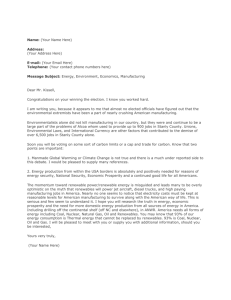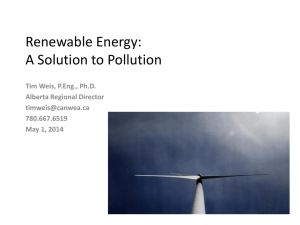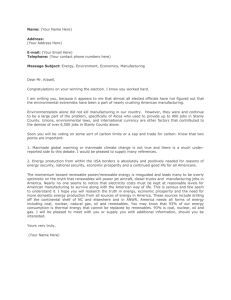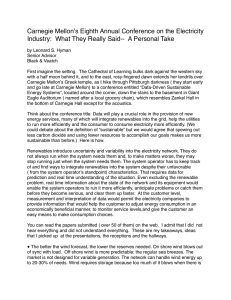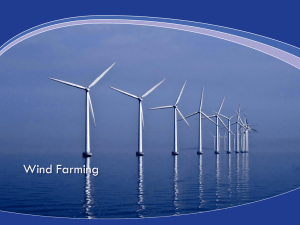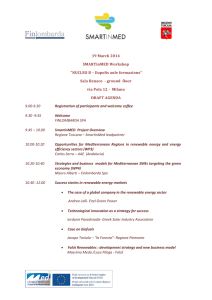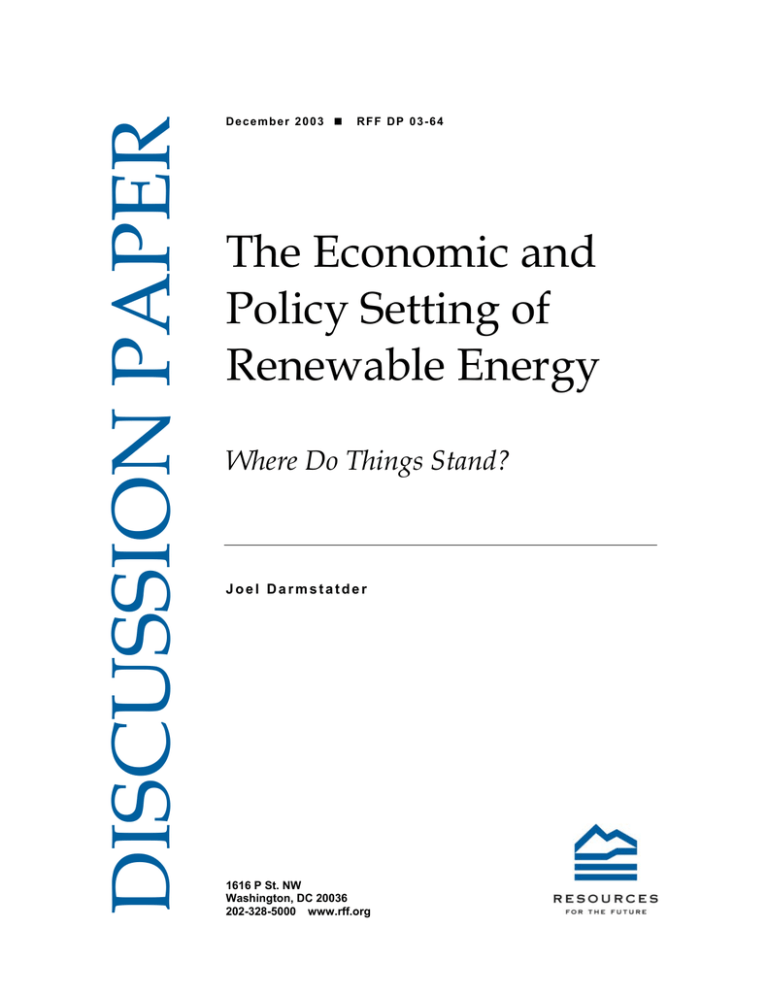
DISCUSSION PAPER
December 2003
RFF DP 03-64
The Economic and
Policy Setting of
Renewable Energy
Where Do Things Stand?
Joel Darmstatder
1616 P St. NW
Washington, DC 20036
202-328-5000 www.rff.org
The Economic and Policy Setting of Renewable Energy:
Where Do Things Stand?
Joel Darmstadter
Abstract
This paper looks at the status and prospects of renewables—with particular emphasis on
windpower—in the electric power sector. Although renewables account for a steadily rising share
of electricity generation in various countries, their role remains small in absolute terms. In part,
this is because of technological progress of and successful competition from fossil-fueled
generation—notably, combined cycle gas turbines. While diminishing, subsidies continue to be
indispensable to the use of renewables in most places. Viability of renewables-based electricity is
undermined by the cost of externalities for which fossil energy combustion is only partially
charged. A number of countries (and states in the U.S.) have launched obligatory requirements
for renewables-based electricity in the years ahead. This so-called “renewable portfolio standard,”
while technology-forcing, offers an opportunity for an economically efficient way of promoting
greater market penetration of renewables.
Key Words: Renewable energy, electricity, windpower, externalities
JEL Classification Numbers: Q21, L94
© 2003 Resources for the Future. All rights reserved. No portion of this paper may be reproduced without
permission of the authors.
Discussion papers are research materials circulated by their authors for purposes of information and
discussion. They have not necessarily undergone formal peer review.
Contents
The Status of Renewable Energy Systems: A Quantitative Review................................... 1
Factors Shaping Market Penetration of Renewables .......................................................... 4
The Conceptual Issue: A Level Playing Field ...................................................................... 7
Policies and Trends in Different Countries ........................................................................ 11
Conclusions and Broad Challenges ..................................................................................... 15
References.............................................................................................................................. 17
The Economic and Policy Setting of Renewable Energy:
Where Do Things Stand?
Joel Darmstadter∗
The state of renewable energy for generating electricity is for the most part widely
understood: the relative contribution of nonhydro renewables to electricity capacity remains
generally very low. At the same time, their importance in some places has been rising fairly
steadily, even if the starting point is so low that annual growth rates can be somewhat
misleading.
In this paper I first review of the state of play of renewables in major regions, with
special emphasis on windpower. I then look at the economic and noneconomic constraints that
have impeded greater market penetration of renewables and consider how the playing field might
be leveled to enhance the prospects for alternative energy systems. Next, in what is mostly a
sifting exercise, I take a selective look at trends, policy initiatives, and problems in specific
countries. Finally, I present a brief set of conclusions and list the broad challenges facing the
renewable energy sector.
The Status of Renewable Energy Systems: A Quantitative Review
Let us start with the numbers. In Table 1, we see that for the three groupings of countries
used by the Organisation for Economic Co-operation and Development (OECD)—North
America, the Pacific region, and Europe—renewables hover at around 2% of total electricity
production. Predictably, some countries depart markedly from that share, such as Iceland and
∗
Senior Fellow, Resources for the Future, Washington D.C.(darmstad@rff.org). Paper prepared for the National
Workshop on the Siting of Coastal Ocean Wind Power, Marine Policy Center, Woods Hole Oceanographic
Institution, Oct. 22–24, 2003. My thanks to Puja Jawahar for valuable assistance in the preparation of this paper.
1
Resources for the Future
Darmstadter
New Zealand, where geothermal energy is tapped; Finland, which grows biomass; and Denmark,
which uses windpower. Germany, the United Kingdom, and the United States are close to the
OECD-wide average of 2%, although rapid change could make such numbers only a point-intime snapshot.
Table 1. Nonhydro renewables, percentage share
of electricity production, 2000.
By regional grouping
OECD total
North America
Europe
Pacific
2.0%
2.0
2.1
1.6
Selected countries
Iceland
Denmark
Finland
New Zealand
Germany
United Kingdom
United States
17.2%
16.7
12.3
8.9
2.5
1.3
2.1
Source: IEA, Renewables Information 2002 (Paris: OECD/IEA 2002).
Table 2 provides OECD-wide data on specific types of renewably generated electricity,
expressed as both shares of generation and shares of installed capacity. Biomass and industrialmunicipal waste resources are still the dominant players here, though as relatively mature
contributors, their growth rates have been very modest. Growth in windpower generation, by
contrast, has proceeded at a 22%-per-year clip, and its 14% share of renewables generation puts
it in at least respectable company. But note: windpower’s installed capacity share is more than
twice its electricity production share.
2
Resources for the Future
Darmstadter
Table 2. Distribution of nonhydro renewable
electric systems, OECD, 2000.
By generation
GWH
Geothermal
Solar
Tidal
Windpower
Biomass
Industrial and municipal waste
Total
32,878
1,128
605
28,897
95,292
49,969
208,769
By capacity
MW
Geothermal
Solar
Tidal
Windpower
Biomass
Industrial and municipal waste
Combined sources and
unspecified
5,644
777
258
16,110
16,173
8,499
2,653
Percentage
5.7
0.5
0.3
13.8
45.6
23.9
100.0
Percentage
11.3
1.6
0.5
32.2
32.3
17.0
5.3
Source: IEA, Renewables Information 2002 (Paris: OECD/IEA 2002). GWH = gigawatt hours or million kilowatt
hours; MW = megawatts or million watts.
That leads us to Table 3, which highlights the technological and economic challenge
posed by renewables with their intermittency and low rates of capacity utilization. The table
shows that recorded annual operating hours for different technologies range from a high of close
to 7,000 hours (i.e., nearly 80% of theoretical maximum availability) for a nuclear power station
down to rates of 17% to 20% for solar and wind systems.
Table 3. Annual hours in operation, different energy systems, OECD, 2000.
Energy source
Hours per year
Nonrenewable: nuclear
Nonrenewable: fossil fuels
Hydro
Geothermal
Solar
Tidal
Windpower
Biomass
Industrial and municipal waste
Theoretical maximum operation (hours in a year)
6,947
4,171
3,336
5,825
1,425
2,345
1,794
5,892
5,879
8,760
Source: IEA, Renewables Information 2002 (Paris: OECD/IEA 2002).
3
Resources for the Future
Darmstadter
A stylized but more complete representation of typical renewable capacity factors
appears in Figure 1. Of course, the capital-intensive outlays required by a nuclear facility would
never be undertaken if the plant could not be expected, at least ex ante, to be deployed as a
baseload—that is, with more or less year-round operation. (The table, incidentally, reveals a
decidedly lower capacity utilization rate for fossil-fueled plants because even though many are,
like nuclear plants, of the baseload variety, periodic recourse to peak-load and auxiliary capacity
provided by older and inefficient sites reduces the overall utilization rate.)
Factors Shaping Market Penetration of Renewables
Aside from successes in a small handful of countries, then, market penetration of
renewables has remained very low. What’s the explanation? The insights I’ve managed to
acquire are based mainly on U.S. experience, though there are numerous aspects of the story that
are more widely applicable.
At its core, the decision of how to expand electricity-generating capacity rests on the
comparative marginal costs of renewable versus conventional systems. To be sure, such a
comparison can be tilted in one direction or another in a variety of ways: the differential
imposition or neglect of external costs, the use of subsidies favoring a particular technology, or
policy dictates that the market is forced to absorb. Examples of such policies in the United States
include ethanol requirements for transportation fuels and, in some states, renewable portfolio
standards (requiring that some percentage of power come from nonhydro renewable sources).
But the fact remains that during much of the past decade, dominant market forces have not been
kind to renewable energy.
A study conducted at Resources for the Future (RFF) in 1999 [1] found that although
both advocates and more agnostic analysts had expected the costs of renewable-based electricity
generation to fall during the 1980s and 1990s, the declines were greater than either group
expected—in some cases, markedly so. A quarter-century ago, the cost of windpower generation,
then estimated at around 60 cents per kWh, was not expected to fall much below 8.5 to 11 cents
per kWh by the year 2000. In fact, recent bids for some new windpower facilities appear to be in
the range of 3 to 5.5 cents per kWh, depending on location (in constant-dollar costs, expressed in
2002 price levels). The cost of solar applications remains substantially higher.
Given the sharp decrease in costs, why has the market share of renewables remained so
low in the United States? Because, to an important degree, the costs of conventionally fueled
electricity generation also fell sharply. Those costs had been expected to head in only one
4
Resources for the Future
Darmstadter
direction—upward—during the final two decades of the 20th century. The U.S. Department of
Energy, for example, had projected that the overall cost of generating electricity would rise about
5% between the early 1980s and the mid-1990s; in fact, it fell 40%. That decline, it is true, was
triggered mainly by an unexpectedly large drop in the cost of fuels used for conventional power
generation. But even apart from future trends in fuel costs, it stands to reason that technological
improvements in power production will apply not just to renewables but to their nonrenewable
competitors as well, thus hampering renewables’ success in gaining market share.
The technology of choice for power generation in the foreseeable future is the highly
efficient combined-cycle gas turbine (CCGT). An advanced version of this turbine may well be
able, within the next decade or two, to produce power below today’s nationwide average
generation cost of around 4 cents per kWh. CCGT may thus constitute a formidable challenge to
windpower and other renewables, most of which, unlike a CCGT baseload plant, bear the
economic burden of intermittency, which limits their ability to dispatch power on demand. Still,
a more recent RFF study, comparing the costs of renewables-based and conventional electric
power facilities coming on line in the United States over the next 20 years, sees windpower
emerging as the most promising renewable [2]. But not surprisingly, windpower’s competitive
attractiveness turns out to be highly sensitive to assumptions about continued progress in
CCGT technology.
Although the specific circumstances have varied, the experience of the United States has
been mirrored elsewhere. In the 1990s, for example, the United Kingdom also began to exploit
the economic benefits of combined-cycle natural gas turbines. In the British case, that
development was stimulated by the forced closure of many inefficient coalmines, whose
production declined by half between 1989 and 1995, and by the coincident availability of North
Sea gas, whose price to electricity generators trailed the overall rate of inflation. All this was
coupled with environmental concerns and pollution abatement laws (which did not go so far as to
make renewables the route to greater environmental integrity). Indeed, the continued subsidies
(until recently) for nuclear power in the United Kingdom have been another deterrent to greater
market penetration of renewables [3].
In contrast to the United Kingdom’s cold-turkey approach, Germany’s continued
subsidization of the coal industry has complicated rather than eased the economic viability of
renewables. Nevertheless, the country’s windpower capacity now stands at an impressive 12,000
megawatts. Even in Denmark, the leading country in terms of the share of generation accounted
for by wind, costs of conventional electricity are still substantially below those of windpower.
5
Resources for the Future
Darmstadter
Indeed, that sort of spread, with minor deviation, appears to characterize a large group of
diverse economies. Table 4, derived from estimates developed in 2001 by the International
Energy Agency, shows the average electricity-generating costs for various generating modes for
the 15-member European Union [4].
Table 4. Recent generating costs, EU.
Energy source
Cents/kWh, 2002 prices
Coal
Combined-cycle gas
Bioenergy
Windpower
Solar PV
Nuclear
4.4
4.0
5.1
9.1
84.3
6.2
Source: IEA, World Energy Outlook: 2001 Insights (Paris: OECD/IEA 2001); IEA figures adjusted to 2002 price
level.
In noting that windpower, for now, remains more than twice the cost of combined-cycle
gas, the International Energy Agency nevertheless expresses the view that “windpower could be
in close competition with fossil fuels within the next decade in locations with very good wind
conditions and under the assumption that current capital costs are reduced.” Under one such
assumption, shown in Figure 1, onshore windpower capital costs decline from around $1,000 per
kW to $750 per kW over the next decade. To be sure, any sharp rise in natural gas prices would
lower that cost-competitive hurdle for windpower investment. Although its scope for significant
expansion may be more limited, bioenergy might also achieve greater cost-effectiveness. Still,
the agency says, growth in renewables “over the next twenty years will rely on the continuation
of government intervention.” But that somewhat bland prediction involves intricate conceptual,
measurement, and policy issues.
6
Resources for the Future
Darmstadter
Figure 1. Capital cost and capacity factors of different renewable systems.
Source: Presentation by Lisa Frantzis, Navigant Consulting, NREL Third Energy Analysis Forum, June 11–12,
2003. http://www.nrel.gov/analysis/presentations_03.html. Accessed Sept. 12, 2003.
The Conceptual Issue: A Level Playing Field
Society is best served by market transactions that reflect both the private and the external
costs of producing goods and services. But this principle of promoting socially efficient
outcomes is undermined in numerous ways. Fossil fuel combustion, for example, releases
harmful by-products not reflected in existing policies. Even some renewable energy systems
create externalities—Cape Cod residents confronting the prospect of wind farms need no
reminder. Ignoring the full costs of different energy systems distorts allocational decisions by
both consumers and producers. The former are induced to overuse an underpriced commodity,
and the latter, unhampered by the need to face up to the costs of external impacts, make
suboptimal investment decisions.
The issue of externalities is related to that of subsidies. Indeed, it is just a matter of
semantics whether one regards the subsidy to, say, a German coal producer as different from an
externality produced by burning coal; in either case, the industry is spared the burden of
7
Resources for the Future
Darmstadter
confronting its real costs. And just to preserve the symmetry, one could argue that the U.S.
windpower producer tax credit of nearly 2 cents per kWh has an equally—some would say
egregiously—distorting effect on electricity market decisions.
Talking about the problem in principle doesn’t do us much good, however, if we can’t get
a handle on the comparative magnitudes of the distortions arising from externalities and
subsidies. And yet that comparison, and the corrective policies needed to deal with it, is at the
core of the argument about the role and prospects of alternative energy systems. It is all well and
good for Glenn Schleede, a perceptive analyst of renewable energy economics, to alert us to the
policy bias extended to wind and other systems [5]. But his virtual silence on favoritism to
conventional energy leaves us with very little basis for judgment. Hence we reach the subject of
leveling the playing field.
Let me start by suggesting how, at least in principle, not to level the playing field:
•Recognizing that since the unpaid cost of coal combustion includes damage from carbon
dioxide and mercury emissions, we cannot right the balance with an offsetting
subsidy to wind or other renewables. All that does is stimulate extra demand for
electricity from both sources.
•Acknowledging that nuclear power has been the beneficiary of government largesse in
the past, we cannot belatedly offset that favoritism through handouts to renewables.
What’s done, however misguidedly, is done; a sunk cost is a sunk cost. To favor
windpower or biomass now would merely compound a historic misjudgment by
adding a questionable new one.
It is beyond the scope of this brief paper to provide even “guesstimates” of the distorting
effects of subsidies and externalities in various countries’ energy markets. That said, for the
United States I have some feel for the extent to which externalities imposed on fossil-fueled
electricity generation would narrow the competitive disadvantage of windpower. My sense is
that requiring, say, coal-fired power plants to absorb added costs for emission-related damage
would still leave wind with an inability to compete, absent the production tax credit I mentioned
a few moments ago. To be sure, so little is certain about the value of damages caused by longterm global warming that one can plausibly, if not probabilistically, assign a carbon charge so
high as to make wind an uncontested winner. On the other hand, the middling $50-per-ton
carbon tax simulated in a recent report, shown in the bottom panel of Table 5, translates into
increments of 0.6 and 1.2 cents per kWh (for gas- and coal-fired plants, respectively) that only
barely provide a competitive opening for wind [6].
8
Resources for the Future
Darmstadter
Table 5. Comparative nuclear and fossil fuel generating costs
under different assumptions ($2002).
Real levelized cost
(cents per Kwe-hr)
Case
Nuclear (LWR)
Reduce construction cost by 25%
Reduce construction time by 4 to 5 years
Further reduce operation and maintenance
costs to 13 mill per Kwe-hr
Reduce cost of capital to that of gas or coal
Pulverized coal
CCGT* (low gas prices, $3.77 per mcf)
CCGT (moderate gas prices, $ 4.42 per mcf)
CCGT (high gas prices, $ 6.72 per mcf)
6.7
5.5
5.3
5.1
4.2
4.2
3.8
4.1
5.6
* Gas costs reflect real, levelized acquisition cost per thousand cubic feet (mcf) over the economic life of the project.
Power costs with carbon taxes
Carbon tax cases, levelized electricity $50 per tonne
costs (cents per kWe-hr)
C
Coal
Gas (low)
Gas (moderate)
Gas (high)
$100 per
tonne C
5.4
4.3
4.7
6.1
6.6
4.8
5.2
6.7
$200 per tonne C
9.0
5.9
6.2
7.7
Notes: LWR = light water reactor; Kwe-hr = kilowatt hours electric; CCGT = combined-cycle gas turbine; mcf =
thousand cubic feet.
Source: Massachusetts Institute of Technology, 2003, The Future of Nuclear Power: An Interdisciplinary Study, 7.
The upper panel of Table 5 indicates possible reductions in nuclear generating costs
compared with coal and combined-cycle gas turbine generating costs under varied natural gas
price assumptions. It shows the baseline cost of various technologies, including hypothesized
ways of reducing the cost of nuclear power. The lower panel shows the additional effect of
different levels of carbon taxes.
Of course, to greater or lesser extents, externalities are associated with all energy sources
and forms—even windpower, as some wind farms’ neighbors are only too eager to remind us.
Thomas Sundqvist [7] has scoured the literature to ascertain the ranges of externality estimates
for different energy systems in different countries, summarized in Table 6.
9
Resources for the Future
Darmstadter
Table 6. Survey of externality estimates.
Cost of externalities (U.S. cents per kWh)
Fuel source
Coal
Oil
Gas
Nuclear
Hydro
Wind
Solar
Number of
observations
28
13
21
14
10
14
7
Minimum
0.31 (U.S.)
0.32 (U.S.)
0.10 (U.K.)
0.01 (Fr., U.S.)
0.02 (U.S.)
0.001 (U.S.)
0.15 (U.K.)
Maximum
58.04 (Be)
31.99 (Fr.)
8.97 (Dk)
64.45 (U.S.)
26.26 (No)
2.53 (De)
1.11 (De)
Median
8.3
12.35
6.15
0.82
0.35
0.27
0.76
Mean
12.52
11.96
4.49
10.09
4.44
0.43
0.68
Source: Thomas Sundqvist, 2001, Regulating Externalities in the Power Sector: Some Lessons from Previous
Valuation Studies, Minerals and Energy 16(1): 21. Abbreviations: Fr = France; Be = Belgium; Dk =Denmark; De =
Germany.
Quite apart from the effect of different methodologies employed in their derivation, the
estimates are decidedly not comparable in terms of their scholarly fastidiousness. Advocacy
positions clearly enter into some of the numbers, such as charging coal and oil 10 or more cents
per kWh.
Still, Sundqvist’s reconnaissance suggests that agreement on both the size of externalities
and their likelihood of adoption may be a futile expectation. This is therefore the juncture at
which to abandon one’s purist trappings and, in fashionable economic policy jargon, allow the
best to be the enemy of the good. Some reasonable degree of government financial support for
struggling yet promising renewable energy systems requires no apologetic rationale. Call it
support for basic research, cite historic instant-industry arguments, demonstrate investment risks
and long-term time horizons, and note the social value (including both domestic and international
security dimensions) of a diversified energy portfolio. If these are objectives that private
investors will pursue only reluctantly, the case for a visible public sector role in renewable
energy policy emerges.
One can debate the magnitude of such support and the form it should take—direct or
indirect financial assistance, mandated renewable portfolio standards, demonstration programs—
as long as it leads to a test of an entrepreneur’s willingness to actually gear up for an output run.
Unfortunately, the more insidious prospect, amply borne out by past government initiatives, is
that such programs routinely become captive to special interests and are reenacted with little, if
any, information on how well they have met the criteria for success.
10
Resources for the Future
Darmstadter
We all have our favorite examples of the institutional inertia that resists dilution of
subsidies once adopted. The canonical example may be ethanol mandates for gasoline blending.
In electricity, nuclear power (whose eventual revival in acceptable fashion we cannot dismiss)
doesn’t lack for boosterism, either. In mid-2003, Sen. Pete Dominici sought to restore proposed
Senate legislation requiring federal loan guarantees, purchase guarantees, and several tax breaks
for new nuclear power generation if “the plant is necessary to contribute to energy security, fuel
or technology diversity, or clean air attainment goals” [8]. You can bet that meeting such vague
conditions would not prove insuperable. I might add that the MIT study summarized in Table 5
provides a thoughtful argument favoring some limited and transitional public support
(specifically, a $200 per kW tax credit) to sustain and significantly enhance the integrity of a
future nuclear option…but there’s that spooky word, transitional. Not surprisingly, the pursuit of
federal energy dollars is a race the wind industry doesn’t want to miss—hence the
understandably frenetic effort by the American Wind Energy Association to ensure extension of
the federal production tax credit beyond 2003.
When we seek to level the playing field, then, we find that sensible comparisons among
energy systems are hampered by the difficulty of divining the extent of externalities and
subsidies. Subsidies, if transparent, aren’t inherently objectionable. But their goals must be
clearly articulated, and progress toward meeting them, periodically evaluated. That task for
energy policy applies equally to renewable and conventional systems.
Policies and Trends in Different Countries
I now turn to particular examples, and here we find, first, that however haltingly,
renewables are beginning to emerge from their coddled and privileged status and seek viability in
the market; and second, that even when support continues, it is more likely to encourage
marketlike and economically efficient character. Of course, impediments to renewables
penetration persist and deserve to be flagged.
Although trends are hard to document, in at least some significant instances, subsidies for
renewables are shrinking. Denmark, where wind constitutes 13% of electricity-generating
capacity, has announced that subsidies for new wind turbines will cease beginning in 2004. The
government still facilitates windpower market penetration, however, by shielding industry from
wind-led price increases, which are shifted to other consumers. Spain, another leading
windpower country, is said to be “considering removal of its renewable energy subsidies” [9].
Nevertheless, substantial continued support of the country’s coal miners—estimated at EUR
11
Resources for the Future
Darmstadter
60,000 per worker in 1999—would hold wind at a greater disadvantage than might otherwise be
the case and may make elimination of renewables support politically tricky.
Sustained support to the coal industry is even more contentious an issue in Germany,
which pumped $1.5 billion into the industry last year and has won from the European Union the
right to continue subsidies at least until 2009. And if harmonizing subsidies among the current 15
EU members remains an elusive goal, the imminent accession of two major coal-producing
members, Poland and the Czech Republic, will scarcely simplify the task.
In the United Kingdom, the problem for renewables-powered electricity hasn’t been
coal—former Prime Minister Thatcher saw to that with forced privatization (and therefore largescale retrenchment) of the industry in the 1980s. Rather, it has been the continued subsidization
of nuclear power that has distorted electric power markets. But that support is now expiring.
Of course, when we learn that one country or another is scaling back support for
windpower or other renewable energy systems, we don’t necessarily know what subsidies
remain. For each of the countries I’ve cited, various types of benefits will persist for some years,
and others are introduced as circumstances are deemed to warrant. For example, the United
Kingdom has instituted a hefty “climate change levy” (amounting to 0.43 pence per kWh in
2003–2004), which, along with several other measures, is said in a recent U.K. white paper “to
provide the renewable industry with support worth around [$1.6 billion] a year. This is designed
to deliver the required expansion in renewables [10% of electricity generation]” by 2010 [10]. A
different study by a royal commission assesses the magnitude and cost of various renewable
resources in the year 2025 [11]. As Table 7 shows, windpower (both offshore and land-based)
comes in at a range equivalent to 5 to 5.5 U.S. cents per kWh in today’s prices—a less ebullient
outlook than some other predictions, but maybe more realistic.
12
Resources for the Future
Darmstadter
Table 7: Electricity from renewable energy, U.K.:
Assessment of cost-effective resources in 2025.
Source
Accessible resource
Total cost-effective
(annual average resource* (annual average
rate of supply, GW)
rate of supply, GW)
Noncarbon-based sources
Onshore windpower
Offshore windpower
Photovoltaics
Small hydro
Alternative carbon-based sources
Energy crops
Agricultural and forestry waste
Municipal solid waste
Landfill gas
Technologies being developed
Wave power
Tidal steam
Cost below which at
least 90% of cost
effective resource is
available (p/kWh)
36.0
468**
30***
n/a
6.5
11.4
<0.1
0.3
3.5
3.0
7.0
7.0
n/a
n/a
1.5 ss
n/a
3.7
2.4
0.8
0.9
4.0
5.0
5.0
3.0
95.0
4.1
3.7
0.3
4.0
6.5
ETSU = Energy Technology Support Unit, part of AEA Technology plc, under contract to U.K. Department of
Trade and Industry. Costs are expressed at the 2000 price level (personal communication).
*ETSU’s estimate of the rate at which electricity could be generated at a cost of less than 7 pence per kWh in 2025,
assuming a discount rate of 8%.
** Assumes a load factor of 0.43
*** In the absence of an estimate for the accessible resource, the figure for maximum practicable resource is given.
SS = total potential at current rates of waste production.
n/a = ETSU did not estimate the accessible resource.
Source: Royal Commission on Environmental Pollution, Energy—The Changing Climate, June 2000, 124
In the United States, the federal production tax credit for windpower, which had widely
been expected to be extended, lapsed at the end of 2003, due to Congress’ failure to enact an
omnibus energy bill. Conceivably, the credit will be restored as stand-alone legislation in the
second session of the 108th Congress. The head of the American Wind Energy Association has
called continuation of the credit as justified by, among other things, the utility industry’s
unfamiliarity with wind farm technology [12]. Exactly how a producer tax credit will provide the
tutorial to overcome such ignorance is unspecified.
Any effort to provide a systematic rundown of the renewables subsidy picture across
countries quickly devolves into the suggestive and anecdotal. But one multicountry development
13
Resources for the Future
Darmstadter
strikes me as distinct: initiatives requiring that by some specified date, some minimum share of
electricity generation be furnished by nonhydro renewables. The renewable portfolio standard
(RPS) has eluded efforts as a federally legislated mandate in the United States, though it is on the
statute books in several states.
Free-market purists, not surprisingly, look askance at such dictates. Rather than join that
debate, I will here suggest only that if kept modest, such technology-forcing measures, though
admittedly somewhat arbitrary, provide the opportunity to inject a degree of economic efficiency
and transparency into electricity market transactions.
Texas, second only to California in installed windpower capacity in this country, is
among the states with an RPS. Retail utilities are required to deliver 2,000 megawatts (in stages)
of renewably generated electricity by 2009, a target that would constitute around 3% of the
state’s electricity supply [13]. Interestingly, the RPS legislation also tightened emissions
standards on fossil fuel combustion—underscoring the fact that the outlook for renewables is
part and parcel a function of having competitors assessed for externalities for which they bear
responsibility. Without that provision, the purpose of the Texas RPS would have been attenuated
by coal’s competitive advantage.
The Texas RPS regime incorporates a tradable credit system among utilities (as is the
case in several other U.S. jurisdictions). The trading scheme seems admirable and helpful as far
as it goes. For example, it prevents runaway escalation of credit costs through provisions that, in
effect, cap credit prices at 5 cents per kWh—a level far above prices at which credit transactions
have taken place. But the problem in Texas, as in other states, is that trades can occur only within
the state’s electricity network, limiting the scope and efficiency of the trading system. Politically,
Texas legislators found it more attractive to have, say, a Corpus Christi utility buy credits from
(i.e., reward) an El Paso utility rather than one in Nevada. And within Texas alone, the market,
currently not very liquid, needs substantial growth in transactions.
With variations among individual countries, Europe appears to be moving in the same
direction. Britain has mandated a 10% renewables share in electricity production by 2010—a
target whose realization is to be facilitated by a system of open certificate trading, allowing
generators that overcomply in meeting their renewables requirement to sell excess certificates to
those that do not. However, the fate of wind or other renewables is not yet entirely at the mercy
of the market; the British government is expected to support the renewables industry with some
$1.5 billion annually. Presumably, as renewables become viable contenders in the electric power
14
Resources for the Future
Darmstadter
market, the need for significant government assistance—in the United Kingdom and elsewhere—
will be reassessed.
One impediment to the integration of renewably generated electricity, not merely within a
given country but across national borders, is the limited nature of efficient, pan-European
electricity markets enabling producers and retailers to hedge against fluctuations in demand and
energy costs, which in turn might lead to lower retail prices. As The Economist observes, the
effort “to make the market more transparent and less volatile…is some challenge, for storing
electricity is next to impossible. Delivering it to the right place at the right time is a precise
science. Producing consistently is a special problem for wind farms, which might produce only
30% of their capacity in a year” [14]. Yet as the article points out, “traders remain innovative.
They have ideas that will help even wind farms to hedge against uncertainty. Entergy-Koch, one
of the few American energy traders still in Europe, offers bets against a monthly wind index for
ten locations. The owner of a wind farm would be paid when wind speeds were low and not
much power is produced and would pay money out when winds were unseasonably strong.
Entergy-Koch has done a few deals—mostly, not surprisingly, with financiers of wind farms.”
Conclusions and Broad Challenges
So where do things stand? The short answer is, as we have seen, “not still.” The
renewables picture in general, and windpower conspicuously, is one of constant and rapid
change, with rates of growth not particularly meaningful and policy initiatives in a state of flux
across countries. Under the circumstances, no crisp summary is possible. Still, five points
deserve emphasis:
•Although subsidization of renewables remains, for now, essential to market success,
stand-alone viability seems no longer remote, particularly for windpower.
•Projections of renewables targets also no longer seem Panglossian, some countries
having stipulated mandated outcomes rather than merely goals. (Of course, what
governments dictate, governments can repeal.)
•No excuse is needed to justify continued public support, particularly in the area of basic
research, for slowly maturing renewables systems.
•Economically enlightened policies and supportive institutional changes are finding their
way into renewables transactions. Examples include tradable credits to meet RPS
requirements; the establishment of trading mechanisms to hedge against price
15
Resources for the Future
Darmstadter
volatility; and the specification of standby rates and net metering for distributed
electricity systems, at least some of which include renewables.
•Leveling the playing field remains an issue. Critics who fault windpower subsidies and
externalities have an obligation to consider the distortions arising from fossil and
nuclear subsidies and externalities.
16
Resources for the Future
Darmstadter
References
[1] J. McVeigh, D. Burtraw, J. Darmstadter, and K. Palmer. 1999. Winner, Loser or Innocent
Victim: Has Renewable Energy Performed as Expected? Washington, DC: Renewable
Energy Project, March, Research Report No. 7.
[2] M. Macauley et al. 2002. Measuring the Contribution to the Economy of Investments in
Renewable Energy: Estimates of Future Consumer Gains. Report to the U.S. Department
of Energy. Discussion Paper 02-05. Washington, DC: Resources for the Future.
[3] See DOE/EIA, Electricity Reform Abroad and U.S. Investment, Chapter 2 (Electricity
Restructuring and Privatization in the United Kingdom), September 1997.
[4] International Energy Agency. 2001. World Energy Outlook: 200l Insights. Paris: OECD/IEA,
317.
[5] A good example is Schleede, Evaluating the Costs and Benefits of Wind Energy: Overstated
Benefits and Understated Costs Create False Hope for Wind Power, released by Energy
Market and Policy Analysis, Reston VA, May 5, 2003.
[6] Massachusetts Institute of Technology. 2003. The Future of Nuclear Power: An
Interdisciplinary MIT Study. Cambridge, MA: MIT, 7.
[7] T. Sundqvist. 2001. Regulating Externalities in the Power Sector: Some Lessons from
Previous Valuation Studies. Minerals and Energy 16(1): 14–31.
[8] See Greenwire, “Industry Seeking Incentives for New Plants, ” August 8. E&E Publishing.
[9] DOE/EIA. 2003. International Energy Outlook 2003. May, 119.
[10] U.K. Department of Trade and Industry. 2003. Our Energy Future—Creating a Low Carbon
Economy. White paper. London, February.
[11] U.K. Royal Commission on Environmental Pollution. 2000. Energy—The Changing
Climate. London, June.
[12] American Wind Association. 2003. Press release, August 20.
[13] DOE/EIA. 2001. State Wind Profiles: A Compendium. In Renewable Energy 2000—Issues
and Trends, Appendix A http://www.eia.doe.gov/cneaf/solar.renewables
/rea_issues/windappa. Html. A more detailed account of the Texas RPS policy is in R.
17
Resources for the Future
Darmstadter
Wiser and O. Langniss. 2001. The Renewables Portfolio Standard in Texas. Lawrence
Berkeley National Laboratory, November 13. http://www.library.lbl.gov/docs
/LBNL/491/07/PDF/LBNL-49107/pdf. Accessed Sept. 15, 2003.
[14] The Economist. 2003. July 26: 69–70.
Note: In addition to the foregoing documents cited or considered in the text, several additional
references may prove useful:
J. Darmstadter. 2002. Whistling in the Wind? Toward a Realistic Pursuit of Renewable Energy.
Brookings Review. Spring 2002: 36–39.
G.R. Schleede. 2003. The True Cost of Electricity from Wind Power and Windmill Availability
Factors. Reston, VA: Energy Market and Policy Analysis, April 7.
M. Kittell. 2003. A Comparison of Renewable Portfolio Standards and Electricity Feed-In Laws.
Unpublished graduate school paper, University of Maryland, May.
Danish Wind Industry Association. 2003. http://www.windpower.org/en/core.htm. See links to
numerous economic, policy and technical topics.
American Wind Energy Association. 2003. Global Wind Energy Market Report. February.
http//www.awea.org/pubs/documents/globalmarket2003.pdf. Accessed September 2003.
R. Williams. 2003. Peak-Oil, Global Warming Concerns Opening New Window of Opportunity
for Alternative Energy Sources. Oil and Gas Journal, August 18: 18–28.
NREL. 2003. Third Energy Analysis Forum, Session II, Global Costs and Benefits of Increased
Use of Renewables. June. http://www.nrel.gov/analysis/presentations_03.html. Accessed
Sept. 2003.
18


